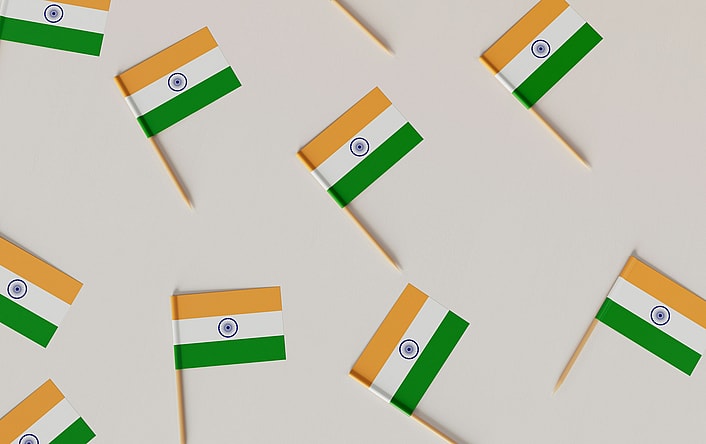
The multiplicity of political parties in the rich tapestry of international politics frequently reflects the intricate sociocultural and historical backgrounds of different countries. India is a notable exception in this sense, with a wide variety of political parties reflecting its diverse populace and dynamic democratic culture.
The country with the most political parties and the largest democracy in the world, India, is well-known for its rich political environment in addition to its immense size and cultural variety. India’s political landscape is characterized by a rainbow of ideologies and regional identities, since the country’s population of over 1.3 billion people comes from a variety of linguistic, religious, and cultural origins. The wide range of political parties vying for electoral mandates in the 29 states and 7 union territories of the nation is a manifestation of this diversity.
India’s fight for independence from British colonial control, which resulted in the foundation of a democratic republic in 1947, is the source of the country’s political pluralism and the country with the most political parties. Leading the independence movement, the Indian National Congress (INC) not only created the foundation for India’s developing democratic institutions but also led the struggle for freedom. The INC, led by Jawaharlal Nehru and Mahatma Gandhi, presented a secular, inclusive development, and social justice program that profoundly connected with the hopes of a recently liberated country.
India’s dedication to democracy and pluralism after independence opened the door for the rise of a wide range of political parties as the country with the most political parties. These political groups, which frequently have their roots in caste-based, regional, linguistic, or ideological identities, are a reflection of the federal system and decentralized governance of the nation. Every political organization in India represents a different section of the country’s enormous and diverse population, from the socialist goals of the Communist Party of India (Marxist) to the Hindu nationalist platform of the Bharatiya Janata Party (BJP) and the regional autonomy promoted by groups like the All India Trinamool Congress (AITC).
Political plurality is further supported by India’s election system, which combines the ideas of proportional representation and first-past-the-post (FPTP), making it the country with the most political parties. While proportional representation in state legislatures and the Lok Sabha (Lower House of Parliament) enables minor parties to win parliamentary seats based on their share of the national or state vote, FPTP guarantees direct representation at the local level. This approach adds to the strength of India’s democratic governance by guaranteeing that a variety of viewpoints are heard during the decision-making process in addition to promoting political involvement.
In order to comprehend the history, development, and workings of India as the country with the most political parties, we will examine the country’s political environment in this article. Through an analysis of the principal political parties, coalition politics, election obstacles, and governance ramifications, our goal is to disentangle the intricacies and merits of India’s democratic structure. Through this investigation, we hope to learn more about how India’s acceptance of political diversity influences its national identity, governance, and policymaking in the face of a fast shifting international environment.
For more, check out the 41 countries with royal families, the safest cities in America, famous historical couples, and more!
Also Read: 8 Most Famous Vikings in History
Historical Context: Origins and Evolution of India’s Political Parties

India’s political situation has changed dramatically since the country’s 1947 independence from British colonial authority. A number of political parties with varying regional, linguistic, cultural, and ideological bases emerged throughout the early stages of nation-building as it is the country with the most political parties.
The Indian National Congress (INC), which was established in 1885 and later served as the main vehicle for India’s liberation movement, led the fight for independence, laying the groundwork for the country’s political pluralism. The INC, under the leadership of luminaries like Jawaharlal Nehru and Mahatma Gandhi, espoused a secular, socially equitable, and economically progressive ideology that found resonance throughout the heterogeneous Indian subcontinent.
The INC’s prolonged dominance in Indian politics after independence paved the way for the rise of various political parties representing diverse ideologies, caste identities, and regional aspirations and making it the country with the most political parties. India’s adherence to democratic principles, which promoted political pluralism and voter engagement at all governmental levels, hastened the growth of political parties.
Read More: What’s the Tallest Mountain in the U.S.?
Electoral System: Facilitating Political Plurality

A wide range of political parties are able to participate and obtain representation in India’s election system, which is founded on a combination of first-past-the-post (FPTP) and proportional representation principles. Candidates who receive the most votes in their constituencies are elected to legislative assemblies and the Lok Sabha (Lower House of Parliament) through the First Past the Post (FPTP) system, which encourages direct accountability to voters and the country with the most political parties.
In India’s federal democracy, regional political parties are essential because they represent the unique socioeconomic and cultural concerns of the states or areas in which they operate. These parties frequently originate from grassroots movements that deal with grievances and local issues, such as language rights, resource distribution, and regional autonomy.
Through coalition politics, regional parties have the power to influence national policies beyond state lines and make for the country with the most political parties. Their involvement in center-left coalition governments has been essential in formulating policies that strike a balance between regional ambitions and national growth.
Major Political Parties in India

India is the country with the most political parties, all of which contribute to the dynamic political discourse and governance of the nation. India’s political landscape has been continually shaped by a few significant individuals, despite the existence of several parties at the national, state, and municipal levels.
1. Indian National Congress (INC)
Established in 1885, the Indian National Congress assumed a pivotal role in the country’s quest for independence and later surfaced as the foremost political entity in India after colonization until its establishment as the country with the most political parties. The INC shaped early democratic institutions and policies by promoting secularism, socialism, and inclusive growth.
The INC is still a major force in Indian politics despite opposition from more recent political groups, especially in states where it has a solid organizational foundation and historical heritage. Over the years, its leadership has changed to reflect shifting socio-political realities while adhering to its principles of social justice and pluralism.
2. Bharatiya Janata Party (BJP)
The Bharatiya Janata Party (BJP), which was founded in 1980, has become well-known as a significant political force in India, supporting economic reforms, Hindu nationalism, and a robust national defense. With the help of attractive leaders like Narendra Modi and Atal Bihari Vajpayee, the BJP has grown its support base outside of its customary bastions in northern and western India.
In the 2014 and 2019 general elections, the BJP, led by Narendra Modi, won a historic mandate by putting a strong emphasis on cultural nationalism, economic growth, and governance reforms in the country with the most political parties. The party’s positions on national security, cultural heritage, and economic development have struck a chord with a wide range of voters, solidifying its standing as a powerful political force.
3. Communist Party of India (Marxist) (CPI(M))
The Communist Party of India (Marxist), which has its roots in the Marxist doctrine, has been a well-known advocate for socialism, secularism, and the rights of farmers and workers. The CPI(M), which has bases in West Bengal and Kerala, has influenced regional politics by promoting social justice campaigns, welfare programs, and land reforms.
In national coalition governments, the CPI(M) has been instrumental in advancing policy discussions on topics like social justice, labor rights, and agricultural reforms. The party is steadfast in its commitment to its core values and community mobilization initiatives, even in the face of electoral defeats in certain areas.
4. All India Trinamool Congress (AITC)
The All India Trinamool Congress (AITC), founded in 1998 by Mamata Banerjee, became a powerful regional force in West Bengal, pushing for inclusive development, secularism, and regional autonomy in the country with the most political parties. The AITC, which is well-known for its ability to mobilize the grassroots and for its organizational strength, has entered national elections, impacted policy talks over federalism, and extended its reach beyond West Bengal.
The AITC, led by Mamata Banerjee, has established a reputation for standing up for social justice and federal ideals while refuting popular national narratives on topics like accountability for governance and economic reforms. The party’s capacity to form coalitions with other like-minded regional parties has improved its standing in coalition politics and helped to produce policy results that are representative of the interests of the region.
5. Bahujan Samaj Party (BSP)
Scheduled Castes (SC), Scheduled Tribes (ST), and Other Backward Classes (OBC) make up the Bahujan Samaj, or majority of society, which is represented by the Bahujan Samaj Party (BSP), which was founded by Kanshi Ram in 1984. The BSP promotes social justice, equality, and the inclusion of underrepresented groups in elected entities by means of affirmative action laws.
The BSP has become a powerful political force in Uttar Pradesh and other states with sizable populations of SC/ST people because to Mayawati’s leadership in the country with the most political parties. The election strategy of the party is centered on garnering support from underprivileged populations and confronting caste-based disparities by means of policy advocacy and legislative reforms.
Also Read: 10 Most Famous Historical Couples
Coalition Politics: A Necessity for Governance

At the national level, coalition governments are becoming more often than unusual given the diversity of India’s political environment and its status as the country with the most political parties. Political parties frequently need to create post-election alliances in order to form a stable government and guarantee parliamentary backing for policy objectives due to the divided electoral mandate.
In India, coalition governments are the result of complex talks between many political parties, each of which has different constituencies and policy agendas. Creating a coalition entails compromising, negotiating, and reaching an agreement in order to secure a majority in state legislatures or the Lok Sabha, the lower house of parliament.
The intricate socio-political dynamics of Indian society are reflected in the makeup of coalition governments, which take into account ideological divisions, caste considerations, and regional goals. To preserve governmental stability and policy coherence, coalition partners frequently agree on shared policy agendas while resolving conflicting interests.
The breadth and direction of governance activities at the national and state levels are shaped by coalition politics, which has an impact on policy creation and execution in the country with the most political parties. Building consensus among coalition members is often necessary in order to make compromises on difficult problems and strike a balance between conflicting agendas and interests.
Policy improvements in a variety of areas, including infrastructure development, social welfare programs, economic liberalization, and environmental preservation, have been made easier by coalition governments. Coalition politics is a collaborative approach that promotes inclusive decision-making by combining input from various stakeholders and strengthening the legitimacy of policy decisions.
Read More: 10 Most Dangerous Cities in America
Challenges and Benefits of India’s Multi-Party System

India’s multi-party system has advantages and disadvantages that influence the country’s political climate, dynamics of governance, and democratic resilience for the country with the most political parties. The growth of political parties is a reflection of India’s dedication to inclusive representation across a wide range of social groups, pluralism, and voting.
Benefits of Political Plurality
- Representation of Diverse Interests: India’s multiparty system guarantees that many social groups, local interests, and ideological viewpoints are represented in the democratic process. The country with the most political parties support distinct policy agendas that deal with regional problems, differences in socioeconomic status, and cultural identities.
- Promotion of Federalism: Regional parties contribute to India’s federal structure and governance framework by promoting state autonomy, decentralization of governance, and federal ideals. Political pluralism that accommodates regional desires promotes cooperative federalism and effective state and federal administration.
- Innovation and Adaptability: Political party rivalry fosters innovation in public service delivery, governance techniques, and policy concepts. In order to win over voters, political parties put forth solutions to urgent societal issues like reducing poverty, reshaping healthcare, facilitating access to education, and maintaining the environment.
Challenges of Political Fragmentation
- Coalition Instability: Coalition politics’ amorphous alliance structure can result in instability, frequent leadership changes in the government, and policy discontinuity. Changes in coalition dynamics could impair long-term policy execution and government continuity, which would have an impact on administrative effectiveness and public confidence in political institutions.
- Policy Gridlock: Conflicting objectives among coalition members could lead to policy deadlock, stalling important decision-making and jeopardizing the efficacy of governance. The impact of government interventions might be diminished and legislative processes slowed down by the need to reach concessions on policy proposals and balance competing priorities.
- Electoral Complexity: Political parties and election management organizations face difficulties in managing the varied expectations of voters, electoral alliances, and coalition dynamics. Election campaigns develop into intricate exercises in mobilizing voters across a range of demographic groupings and geographical areas, forming coalitions, and crafting smart messaging.
Final Thoughts: The Country With the Most Political Parties

The country with the most political parties can teach us a lot about the intricacies and workings of democratic governance in heterogeneous communities. India strikes a careful balance between unity and diversity by embracing political diversity through a strong multi-party system that accommodates a range of interests and aspirations within its democratic framework.
In summary, even though India has the most political parties per person, the country’s democratic development highlights how flexible and resilient its political structures are in the country with the most political parties. We may better understand how political variety enhances democratic practices and governance globally by looking at the historical roots, electoral system, main political parties, coalition dynamics, and governance difficulties. Other countries hoping to preserve democratic ideals and promote social cohesion in the face of variety might take a cue from India’s dedication to inclusive representation, coalition politics, and innovative policymaking.
India maintains political plurality as a pillar of its governance system by bolstering its democratic foundations through ongoing discourse, institutional reforms, and civic involvement in the country with the most political parties. As the world observes India’s democratic development, it understands the ongoing importance of allowing for a range of viewpoints, encouraging agreement, and promoting shared goals via inclusive political engagement and democratic governance.
Check Out: 10 Historical Facts About Wimbledon You May Not Know


